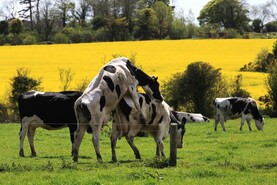At today's ICBF genetics conference in Athlone, the focus shifted to the beef side of the house.
A number of key note speakers took to the stage addressing a number of topics.
Once again, the direction of the €uro-Star replacement index attracted a number of questions for the open discussion.
Breed characteristics
The Irish Farmers Journal put forward the question whether the panel saw the chasing of one overall index run the risk of seeing individual breeds being lost by losing specific breed characteristics and traits in the search of one complete animal.
Leading the reply was the ICBF's Dr Andrew Cromie: “The answer to your question is yes; you are trying to focus these breeds on what’s important in terms of profitable suckler beef production in Ireland.
“It’s those 60/70,000 beef farmers that are buying the bulls and what’s important for them is an increased level of uniformity.
"We hear this all the time. They want weanling efficiency, calf per cow, good weights on those calves, etc.
"Our goal then has to be to facilitate in helping them identify the bulls which are going to be consistent with that overall breeding goal.
"If you’re going to move an industry, you have to have a goal.
"The goal here in Ireland is around calves per cow, female fertility, good weight for weanlings and the lighter cow. Those are the key traits that are driving it."
Adding to these comments, the ICBF’s Pat Donnellan said: “We do the Gene Ireland breed meetings; all the breed representatives there are all uniform in what they want.
"None of them want hard calved, none of them want cows that won’t have any milk and none of them want a cow that doesn’t have a calf.
"So there’s great uniformity across the breeds in terms of traits they agree on.
"In terms of specific traits, that’s a different day’s work, but definitely there’s great agreement across the breeds in the key traits.”
Following on from this question, Rose Goulding of NCBC posed the question “are ICBF confident that the €uro-Star index fits all production systems?”
She explained how in Australia indices have been totally separated for whether you want grass-based or more feed-lot systems and wondered if the ICBF was confident our system fits all or whether separating the indices was something that will be looked at down the line.
Andrew Cromie answered: “Are we confident that the index is absolutely operated at 100% for each one of those production systems and the answer to that question is no.
"Are we confident that it operates at 80% for each of the individual variations of what you’re talking about, then the answer to that question is yes.
“We have to come back to the conversation of will you gain more from having one index that’s 100% good for this one system but tapers off down.
Better approach
“Is that a better approach, or would we be better off to have an index for each of the systems and deal with the potential challenges that then presents.
"For example, on a sales catalogue or mart board, OK, he's five stars, but for which system.
"It introduces another level of complexity to something we are constantly being told people want more simple. It’s a trade-off and when you trade off it's never perfect.
"But our view down the years is to hold strong on a single index that largely covers all the production systems, is not exactly perfect for, but largely covered.
"That’s the approach we’re taking and have always taken in Ireland. Unless something is very clearly going off in a wrong direction, I don’t think it’s one we would be changing at this point in time.”
Open discussion
The open beef discussion closed off a very educational two days about all genetics.
Delegates across the dairy, beef and sheep sectors got to listen to some of the world's industry leaders in terms of genetics and found out just how advanced and recognised Ireland is with regard to genetics on a global scale.






 This is a subscriber-only article
This is a subscriber-only article









SHARING OPTIONS: